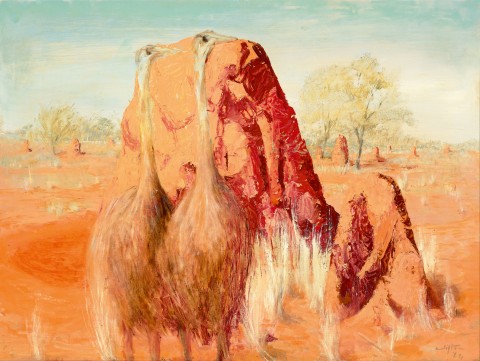EMUS AND ANTHILLS, 1964
CLIFTON PUGH
oil and enamel on composition board
91.0 x 122.0 cm
signed and dated lower right: Clifton / ‘64
inscribed with title verso: EMUS & ANT HILLS / WA
The National Australia Bank Art Collection, acquired in 1965 (label attached verso)
Clifton Pugh has long been considered one of Australia's leading painters. His broad appeal has spanned decades and his contribution to Australian portraiture was outstanding, as his three Archibald Prize winning portraits attest. As the bipartisan court painter to Canberra's colourful political classes throughout the 1960s and 70s, Pugh's portraits live large in the collective psyche of many Australians. His celebrated 1972 Archibald Prize winning portrait of The Hon. Gough Whitlam PM, is arguably one of the finest portraits painted in Australia.
Apart from art and politics, Pugh's other great love was the environment. Clifton Pugh was an early and passionate environmentalist, and both his understanding of the landscape and love of nature underpin many of his works. Indeed, it is in the landscape that Pugh's work reaches its inventive lyrical heights, whether it be the drought-ravaged outback or the lush bush surrounds of his home at Dunmoochin, near Cottles Bridge, then on the outskirts of Melbourne.
Pugh's landscapes have a structural unity that ties the various elements together. There is a harmony between the subject and the ground, something that he also used to great effect in his portraits. In Emus and Anthills, 1964 the forms of the emus meld with the anthills, their shapes echoing one another. The landscape is ancient and dry. A few straggly trees provide some shade and the termites that created the anthills will provide food as a last resort, if the emus get desperate. Here depicted here as survivors shaped by millennia, these land-bound, nomadic birds are proud, wary, knowledgeable – and equipped to thrive in this harshest of environments.
Pugh was a master of all mediums and adept at combining almost any materials. Enamel house paint was a favourite, which he often used as it created a glassy ground on which the artist could manipulate oil paint to great visual effect. The end results of this combination leave the work with a fresh, spontaneous feeling, bristling with nuanced detail.
Pugh’s painting trips to the outback were legendary. Tibooburra, in particular, was a destination Pugh and his friends, including Russell Drysdale, would return to time and again, and Pugh’s mural of a naked Bacchus still dominates the front bar of The Family Hotel. Painter and printmaker, Max Miller, who accompanied Pugh on many painting trips enjoyed recounting the story of how Pugh, when working in the outback heat, preferred to paint while naked – with the local Indigenous community finding the sight of a white guy dressed only in a wide brimmed hat quite hilarious. Emus and Anthills predates these events but is born nevertheless from Pugh’s love for, and understanding of, the Australian outback.
HENRY MULHOLLAND
